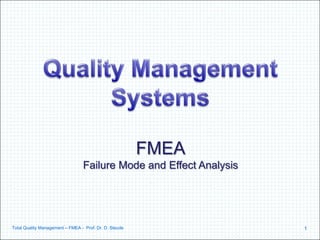Die Fehler-Möglichkeits- und Einfluss-Analyse (FMEA) ist eine systematische Methode zur Identifizierung und Vermeidung potenzieller Fehler in der Produktentwicklung und Fertigungsplanung, die ihren Ursprung in den 1960er Jahren bei der NASA hat. Sie wird in verschiedenen Bereichen eingesetzt, insbesondere in sicherheitskritischen Systemen, und umfasst verschiedene Phasen des Produktlebenszyklus, von der Entwicklung bis zur Nutzung. Die FMEA beinhaltet Elemente der Risikoanalyse, -bewertung und -minimierung, die in Form von Verantwortlichkeiten und Maßnahmen dokumentiert werden.

















